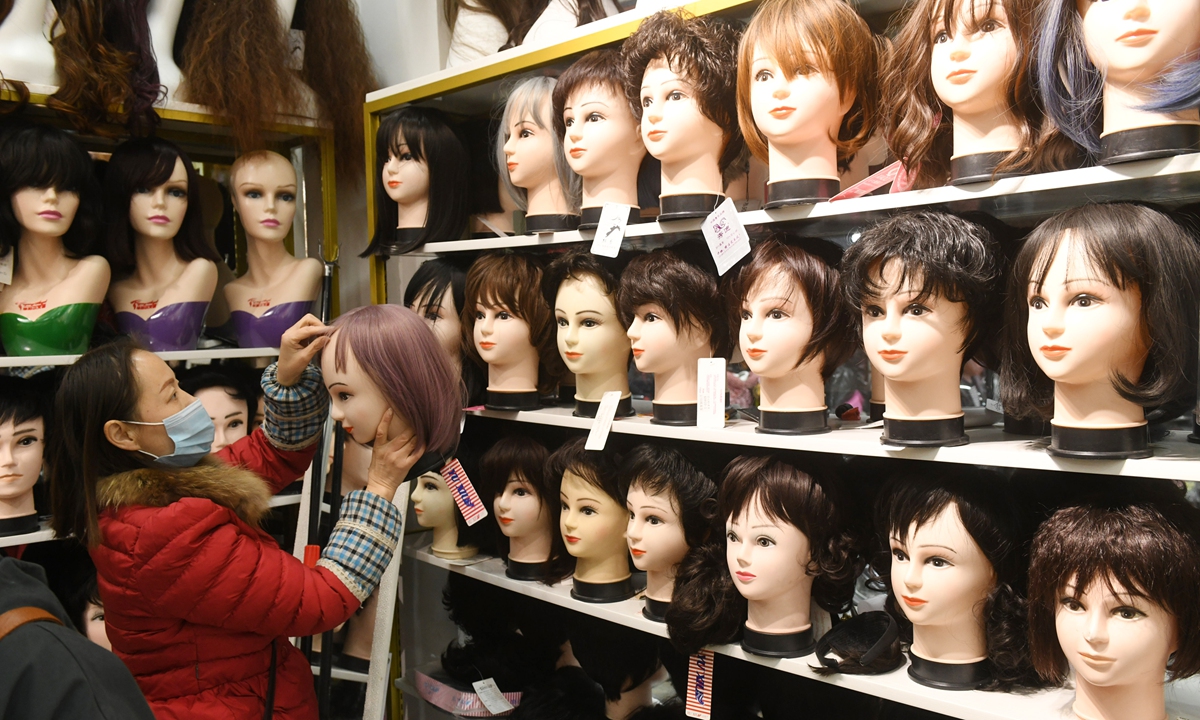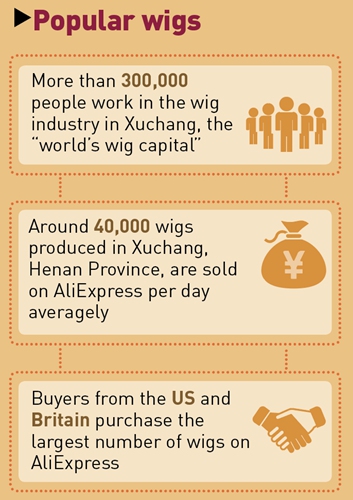China's hair business growing amid pandemic and industry irregularities
Wig industry remains plagued by lack of standardization, quality control

A seller puts wigs in order at a store in Fuyang, East China's Anhui Province on December 6, 2020. Wig sales have become popular in the city over recent years with typical consumers middle-aged and senior citizens. Photo: cnsphoto
Customs in Kunming, capital of Southwest China's Yunnan Province, has recently arrested 10 real hair smuggling groups in partnership with multiple customs. The smuggled hair has a total value of more than 1.1 billion yuan ($167 million), with 230 million yuan of taxes being evaded, reported the China Media Group.The cases reflected the irregularities in China's wig business as it has become a massive industry in the past decade, not only witnessing rising demands in the domestic market but also seeing rapid expansion in exports.
Industry insiders also expressed to the Global Times that they are hoping for a unified industry standard which they said is important in "retaining" customers.

A massive industry
In recent years, China's wig business including those made of human hair and chemical fiber, has mushroomed at a stunning pace as domestic customers are gradually overcoming psychological barriers about wearing wigs while overseas clients get access to China-made wigs with help of the Internet.
Now, there are thousands of wig factories in China, mostly located in East China's manufacturing hub Yiwu in Zhejiang, Henan's Xuchang which is dubbed "the world's wig capital" and Qingdao in East China's Shandong Province. About 30 percent of the wigs are sold in China while the rest are exported, particularly to the US, European and African countries, said Zheng Jiangmin, manager of the Dongyang Lansi Wig Co, a wig producer.
The US is the largest market for Zheng's company, which accounted for about 60 percent of its total sales. "It's interesting that every time the Trump administration sent money to American families through stimulus plans, our sales would see a spike," he told the Global Times on Monday. His company's total sales amounted to about 200 million yuan last year.
Overseas demands are the primary force behind China's wig industry. According to data provided by Chinese international e-commerce platform AliExpress, the platform's turnover for wigs doubled in April 2020, with African countries seeing the fastest growth in demands for Chinese wigs. Generally, one China-made wig is sold every two seconds on the platform.
Industry participants also told the Global Times that their business had seen signs of recovery this year after undergoing a somewhat difficult year in 2020.
"Our sales have started to decrease since last September which I think is a reason of the pandemic which cuts demands for non-rigid daily articles. But recently it started to climb again," Zheng said.
Zhang Tianyou, deputy general manager of China's wig giant Rebecca, said that his company's turnover had dropped by about 30 percent last year as a result of the pandemic which caused labor force to shrink and inconvenient delivery. But he said he should be relatively optimistic about this year's business performance. Currently, overseas markets accounted for about 80 percent of his company's total sales, with Africa being the largest market.
A representative from Dailixiu Wig surnamed Huang also told the Global Times that his company, which focuses on online sales, saw revenues rise by at least 20 percent year-on-year this year, a phenomenon which he said is mostly due to a shift from offline to online sales during the pandemic.
Need for standardization
The rising wig business in China has given birth to a whole industry chain including importing wig materials, like the above-mentioned human hair. As such business activities become increasingly active, irregularities and chaos also emerged.
According to the industry observes, wig makers had to import human hair from overseas countries, mostly from India and other Asian countries, because it's increasingly harder to source real hair strips in China, while the costs of overseas human hair is also cheaper, providing an ample profit margin.
Zhang said that the cost of human hair in India used to cost only half of that in China. "Of course, their cost also rose in recent years but there's still a gap," he said, adding that Indian people seldom dye their hair so the quality is relatively good.
The China Media Group report also noted that overseas hair cost about 1,000-3,000 yuan for each kilogram, but it can be sold at about 10,000 yuan in China, generating ample profit.
Huang said that wig companies could make about 15-25 percent profit off wigs made of fibers and other non-real hair materials, but it should be much narrower profit compared with real hair wigs.
The high profitability of real hair wigs, higher than wigs made of fibers, has caused people to swarm into the industry.
According to Zheng, the market share of real hair wigs is expanding at a fast speed in China, as those are often considered suitable to be worn on heads while fiber-made wigs are only for entertainment uses. In overseas markets, elderly white customers also prefer real hair wigs.
However, industry practitioners also expressed concerns about the state of China's wig industry, as although the market is burgeoning in general, the cake is becoming smaller for each company.
Zhang said that the competition in the industry is becoming fiercer in China, as too many people have flocked into the industry. Some of them have used illegal means, like tax evasions to increase profit margin, but that has affected the ecosystem of the industry in general.
Zheng said that the industry lacks a unified industry standard, which means that the wigs' quality often differs from one factory to another. "I used to order wigs from multiple Yiwu factories [for exports], and found that they are often of different standards from color to size to quality. This makes it very hard for us to send them to overseas clients in a total batch."
He eventually set up his own factory with the intention to unify quality. "So far there's no official standard for wig manufacturing in China, and if there's any standard, it is groped and made by the industry practitioners themselves," he said.
According to him, the entire value chain should be established from wig exhibitions to competitions if Chinese wig brands are to take hold in international markets.



